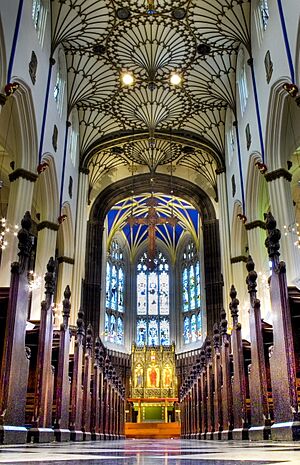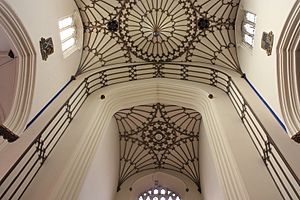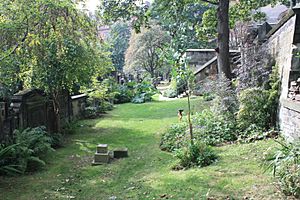St John's, Edinburgh facts for kids
Quick facts for kids St John's Church |
|
|---|---|
| The Parish Church of Saint John the Evangelist | |
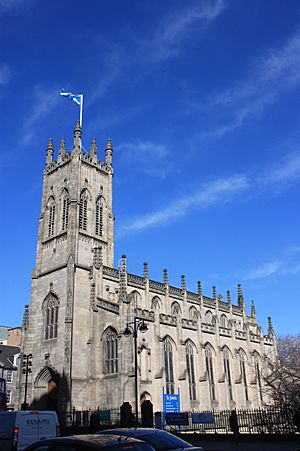 |
|
| Location | 1A Lothian Road, Edinburgh EH1 2AB |
| Country | Scotland |
| Denomination | Scottish Episcopal Church |
| Website | St John's Episcopal Church, Edinburgh |
| History | |
| Status | Active |
| Dedication | John the Evangelist |
| Dedicated | 19 March 1818 |
| Architecture | |
| Functional status | Parish church |
| Architect(s) | William Burn |
| Architectural type | Neo-gothic |
| Groundbreaking | 1816 |
| Administration | |
| Diocese | Edinburgh |
The Church of St John the Evangelist is a Scottish Episcopal church. It is located in the heart of Edinburgh, Scotland. You can find it at the west end of Princes Street, where it meets Lothian Road. This historic building is protected as a category A listed building.
Contents
History of St John's Church
The church was officially named St John's Chapel on Maundy Thursday in 1818. Its construction started in 1816. The building was designed by a talented architect named William Burn. He was only 25 years old when he created the plans.
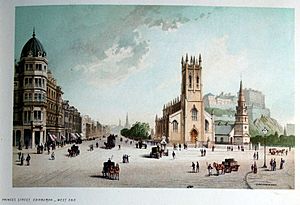
The church community began in 1792. That's when Daniel Sandford came to Edinburgh. He started a ministry that followed the Church of England's ways. In 1797, the congregation moved to Charlotte Chapel. This chapel was rebuilt to be larger in 1811. To pay for a new church, they sold shares. A banker named Sir William Forbes was a key supporter. Charlotte Chapel was later sold to the Baptists.
Edward Bannerman Ramsay became a curate at St John's in 1827. He took over as minister in 1830 after Bishop Sandford. He stayed until he passed away in 1872. He also served as Dean from 1846.
The sanctuary and chancel parts of the church were built between 1879 and 1882. This work was done by Peddie & Kinnear. The vestry and Hall were added later, from 1915 to 1916. These additions were designed by John More Dick Peddie and Forbes Smith.
A war memorial was added in 1919. It was designed by Sir Robert Lorimer. Lorimer also designed and supervised the addition of special ceilings. These were added when Lothian Road was made wider in 1926.
St John's holds church services every day. It is one of the few Episcopal churches in Scotland that still has a weekly Matins service.
Church Design and Features
The church has a unique plaster ceiling. It is a pendant fan vault style. This design was inspired by the Henry VII Chapel in Westminster Abbey.
Most of the beautiful Stained glass windows were made by Ballantine. However, the large east window was created by William Raphael Eginton.
The morning chapel was decorated by Walker Todd in 1935. In 2018, a new extension was added to the south-east side of the church.
Important People Connected to St John's
Many important people have served as rectors (main priests) at St John's Church. Markus Dünzkofer was the rector from 2013 until 2024.
Memorials and Notable Burials
The church and its graveyard are home to memorials for many famous people. These include:
- General Sir John Campbell, 2nd Baronet
- Artist Sir Henry Raeburn
- Dean Edward Bannerman Ramsay, who was a long-serving minister at St John's.
- John Stuart Stuart-Forbes, who died in a famous battle in North America in 1876.
The graveyard also contains the graves of many notable individuals, such as:
- The Rev Archibald Alison and his son William Pulteney Alison.
- Lesley Baillie, who was the subject of a poem by Robert Burns.
- Sir William Hamilton, 9th Baronet, a well-known thinker.
- James Syme, a famous surgeon.
- Peter Guthrie Tait, a physicist.
- Malvina Wells, who was born enslaved and is the only known person with this background buried in Edinburgh.
Community and Festivals
St John's is part of "Edinburgh City Centre Churches Together." This group includes two other churches: St Andrew's & St George's West and St Cuthbert's. They work together in the New Town of Edinburgh.
The church also hosts the Just Festival every August. This festival happens at the same time as the Edinburgh Festival Fringe. It focuses on spirituality and peace.
The Ethiopian Tabot
An Ethiopian tabot was found in storage at St John's Church. A tabot is a replica of Moses' Tablets of Law. In February 2002, it was returned to Addis Ababa, Ethiopia.
Church Policy on Marriage
In 2017, the Scottish Episcopal Church made a change to its rules about marriage. This change allowed clergy, with their congregation's agreement, to perform marriages for all couples. The first such marriage in an Anglican church in the British Isles took place at St John's in September of that year. The church's rector led the ceremony.
See also
- St Kentigern's Church, Edinburgh (Union Canal), which started as a mission from St John's.


